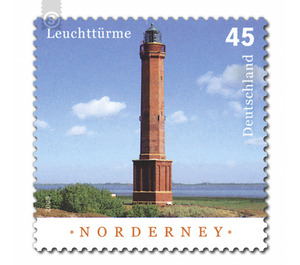Lighthouses - Germany / Federal Republic of Germany 2009 - 45 Euro Cent
Theme: Architecture
| Country | Germany / Federal Republic of Germany |
| Issue Date | 2009 |
| Face Value | 45.00 |
| Stamp Type | Postage stamp |
| Item Type | Stamp |
| Chronological Issue Number | 2615 |
| Chronological Chapter | GER-BRD |
| SID | 555625 |
| In 34 Wishlists | |
In wind and weather, day and night, they have been reliable signposts for shipping on the German coast for over 800 years. From the Jade Bay in the west on the North Sea coast to Usedom on the easternmost section of the German Baltic Sea coast are about 200 beacon buildings. For up to 50 kilometers, the signals of the mighty towers radiate out to sea. But there are also small plants with less charisma and therefore only local significance. Each beacon is recorded on the nautical charts with a specific light signal sequence, which makes it unmistakable and enables orientation in conjunction with other beacons. The special stamp series "Lighthouses" draws attention to the diversity of German lighthouses. The two stamps with the motifs Leuchtturm Norderney and Dornbusch appear on July 2, 2009 in the context of this series. For 134 years, the landmark of the island of Norderney has provided orientation for the shipping industry. The construction of the octagonal brickwork was commissioned in 1872 by the then Royal Building Inspectorate to the north to improve the incomplete firing between the islands Borkum and Wangerooge. At that time, the bricks needed to be completed with small fishing boats from the mainland to the island. On 1 October 1874, the lighthouse started operation. 253 steps lead up to the 53.60 meter high tower, which has a height of 59.60 meters from its slightly elevated position. The lighthouse serves as orientation for the ships passing by the East Frisian Islands. The viewer sees three flashes of light that recur regularly. This signal is generated by a worldwide unique optics. Around an electric lamp turns an optical body that has 24 sides. Each page consists of a lens apparatus, which bundles the light into a beam. But since every fourth of these lenses is darkened, occurs for the viewer after three light signals a short break. The light signals are still visible from almost 40 kilometers away. Until 1959, the clockwork-type turning mechanism was powered by a four-ton "clock weight," which had to be rebuilt every day.


